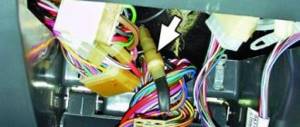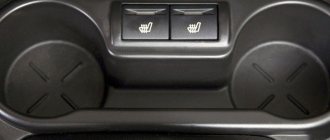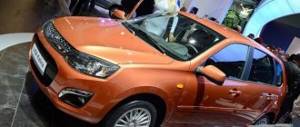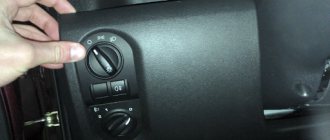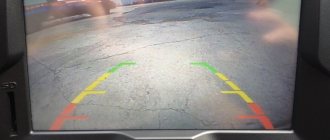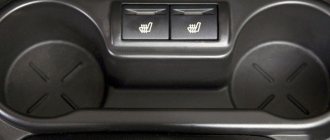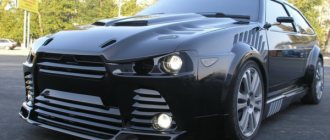The relay and fuse box is also called the mounting block or black box. If problems are identified in the car related to electrical equipment, first check the fuses and relays. If they burn out, we replace them with the same ones, but first we must determine the cause of the burnout.
Where are the fuses for LADA GRANT?
Probably not everyone knows the location of the fuses on the Grant, especially if you just purchased this car. In fact, everything is simple: the main mounting block is located in the cabin on the left side directly to the right of the headlight control unit.
To open the lid, pull the lower left corner of the lid and release the left locking point. Then release the top points and remove the cover. The lid is closed in the reverse order; you just need to make sure that all the latches snap into place.
On the plastic cover on the reverse side are drawn all the symbols and elements for which each fuse and relay is responsible.
Fuse box
The fuse box in Grant is located to the left of the steering column, near the light switches. To remove the cover and access the fuses and relays, pull the top left side of the cover towards you. It’s made conveniently, everything is at hand and you don’t have to climb anywhere when getting up from the driver’s seat. Maybe this is a hint that they will often have to be changed, or maybe just convenience - the developers know better.
F1 (15 A) - engine control unit, injectors, ignition coil, cooling fan relay, short circuit 2x2
.
If you have problems with electronics, and replacing this fuse does not help, in the worst case scenario, you will have to reflash the ECU or replace it. Also, if this fuse blows, the injectors and ignition coil stop working, which makes engine operation impossible. Therefore, if the Grant does not start, check this fuse first.
F2 (30 A) - electric windows
.
If they do not work and replacing the fuse does not help, try unplugging it completely or removing the terminal from the battery for a couple of minutes, then connect it again. In this way, all temporary errors should be reset and if this is the case, the power windows will work again.
F3 (15 A) - alarm
. If it doesn’t work, check this fuse, as well as the emergency light button, its contacts and the functionality of the lamps.
F4 (20 A) - windshield wiper, airbag
. If the airbag warning light on the instrument panel comes on, check this fuse. The problem could be either in it, or in the electronic unit, or in the pillows themselves.
If the windshield wiper does not work and this fuse is intact, also check relay K6, the power handle, the reliability of the connectors connected to it, as well as the electric wiper drive itself.
F5 (7.5 A)
— terminal 15 of the ignition switch. If you have problems turning on the ignition, check this fuse, as well as the reliability of the wire connections to the lock terminals.
F6 (7.5 A) - reverse lamp
. If it does not work, but this fuse is intact, check the lamp itself, as well as the contacts connecting the connectors to the headlight.
F7 (7.5 A) - Mass air flow sensor, adsorber valve, oxygen sensor, speed sensor
. If the engine runs erratically, does not idle, or stalls spontaneously, the problem may be this fuse or the corresponding sensor. We already had an article about that.
F8 (30 A) - heated rear window
. If it does not work, check this fuse, the terminals connecting the wires to the heater, and the integrity of its elements.
F9 (5 A) - right side lamps
F10 (5 A) - left side lamps
. If the dimensions do not light up, the problem may be in these fuses or in the lamps themselves, as well as their connectors. It wouldn't hurt to check the headlight switch on the dashboard.
F11 (5 A) - rear fog lights
. If they do not work, but this fuse is intact, the problem may be in the switch on the dashboard or in the lamps themselves, as well as their connectors
F12 (7.5 A) - right low beam lamp
F13 (7.5 A) - left low beam lamp
. If the low beam does not work in two headlights at the same time, the problem may be in the K9 relay, or in the low beam switch knob and its contacts. If only one lamp does not light, it is most likely the fuse or the lamp itself that needs to be replaced.
F14 (10 A) - right high beam lamp
F15 (10 A) - left high beam lamp
. If both high beam headlights do not work, the problem may be in relay K7. If there is only one, replace the fuse and/or lamp.
F16 (10 A) - Front right fog lamp
F17 (10 A) - Front left fog lamp
. If they do not work, check the switch on the dashboard and its contacts. If one fog light does not work, the lamp is most likely burned out and needs to be replaced.
F18 (15 A) - heated front seats
. If it does not work, but the fuse is intact, check the heating button on the dashboard.
F19 (10 A) - ABS
. If, when you press the brake pedal on a slippery road, the wheels lock and the pedal does not spring back, then the ABS is not working and the problem may be in this fuse or in the mechanical elements of the braking system.
F20 (15 A) - diagnostic connector, horn, trunk lock, gearbox, cigarette lighter
. The very frequent blowing of this fuse is usually caused by a short circuit or incorrect connection of devices to the cigarette lighter socket. If the trunk does not open, it may be due to the cigarette lighter. Replacing this fuse should solve the problem.
F21 (15 A) - electric fuel pump
. If the car suddenly stalls in the middle of the road and there is very little gas in the tank, this fuse may have blown. Without load (without gasoline), operation of the fuel pump can lead to its failure. Therefore, refuel and check this fuse.
F22 (15 A) - central locking
.
If, for example, only the central locking of the driver's door works, and the others do not lock, the problem may be in this fuse, as well as in the control unit. It is better to entrust diagnostics and repairs to specialists if you have no experience.
F23 (10 A) - daytime running light lamps
. If the lights on both sides don't work, it's most likely the fuse or the switch on the dash. If the lamp does not work on only one side, most likely the problem is in the lamp itself.
F24 (7.5 A) - air conditioning
. If it does not work and this fuse is intact, it may be the switch on the dashboard. It is better to entrust the diagnosis of the air conditioning system to specialists. It may require refueling or servicing.
F25 (10 A) - interior lighting, brake lamps
. If the brake lights do not work and this fuse is intact, the problem may be in the lamps themselves and their connectors or in the brake light switch in the pedal drive.
F26 (25 A) - ABS
. Same as F19
F27 - reserve F28 - reserve F29 - reserve F30 - reserve
F31 (50 A) - heated windshield
F32 (30 A) - heater, electric power steering
. If you experience uneven operation of the power steering when turning the steering wheel or the steering wheel turns with difficulty, check this fuse. It could also be a problem with the electronic control unit or insufficient brake fluid level in the electric power steering reservoir.
The relays are located in the same fuse and relay box, which is located to the left of the steering column under the cover.
K1 - heater fan relay
K2 - power window relay
. If they do not work, also check fuse F2; if this does not help, then the problem may be in the control unit.
K3 - starter relay
. If it does not work (does not turn) and this relay is working, check the battery charge level. It could also be a problem with the retractor or the ignition switch and its contacts.
K4 - ignition switch terminal 15 relay
K5 - turn signal and hazard warning relay
. If the turn signals come on and do not turn off, this relay may be shorted. Also check fuse F3 (emergency mode).
K6 - wiper relay
. Check also fuse F4.
K7 - high beam relay
. Also check fuses F14 and F15 and the lamps themselves.
K8 - horn relay
. Also check fuse F20, signal switch contacts on the steering wheel.
K9 - low beam relay
. Also check fuses F12 and F13 and the lamps themselves.
K10 - rear window heating relay
. If the heating does not work, the problem may be in fuse F8.
K11 - engine control unit relay
. Also check fuse F1.
K12 - electric fuel pump relay
. Also check fuse F21.
Detailed diagram of fuses and relays Lada Granta
Old sample (until September 2020)
| Fuse | Current strength, A | Protected circuit |
| F1 | 15 | — Relay for turning on the engine cooling fan — Short circuit 2x2 — Controller (engine control unit) — Injectors — Ignition coil |
| F2 | 30 | Electric windows |
| F3 | 15 | Alarm |
| F4 | 20 | — Windshield wiper — Airbag |
| F5 | 7,5 | Ignition switch terminal 15 |
| F6 | 7,5 | Reversing light |
| F7 | 7,5 | — Canister valve — Mass air flow sensor — Oxygen sensor 1/2 — Speed sensor |
| F8 | 30 | Rear window defroster circuit |
| F9 | 5 | Side lights on starboard side |
| F10 | 5 | Side lights on the left side |
| F11 | 5 | Rear fog lights |
| F12 | 7,5 | Low beam on starboard side |
| F13 | 7,5 | Low beam on the left side |
| F14 | 10 | High beam on starboard side |
| F15 | 10 | High beam on the left side |
| F16 | 10 | Front fog lamp on starboard side |
| F17 | 10 | Front fog lamp on the left side |
| F18 | 15 | Heated front seats |
| F19 | 10 | ABS (Anti-lock Braking System) |
| F20 | 15 | — Horn — Trunk lock — Transmission — Cigarette lighter — Diagnostic connector |
| F21 | 15 | Electric fuel pump |
| F22 | 15 | central locking |
| F23 | 10 | Daytime Running Lights |
| F24 | 7,5 | Air conditioner |
| F25 | 10 | — Interior lighting — Brake light |
| F26 | 25 | Anti-lock braking system |
| F27 | — | Spare |
| F28 | — | Spare |
| F29 | — | Spare |
| F30 | — | Spare |
| F31 | 50 | Heated windshield |
| F32 | 30 | — Heater — Electric power steering |
Relay
| Relay | Description |
| K1 | Heater fan relay. |
| K2 | Power window relay |
| K3 | Starter relay |
| K4 | Ignition switch terminal 15 relay |
| K5 | Turn signal and hazard warning relay |
| K6 | Wiper relay |
| K7 | High beam relay |
| K8 | Horn relay |
| K9 | Low beam relay |
| K10 | Heated rear window relay |
| K11 | Controller relay (engine control unit) |
| K12 | Electric fuel pump relay |
Lada Granta fuse box under the hood
| F1, 50A | Electric power steering; |
| F2, 30A | Heater fan |
| F3, 60A | Generator |
| F4, 60A | Generator |
| F5, 30A | Dipped headlights. |
New sample (from September 2020)
Features of the first mounting block
Once you know where the blocks are, you can talk about their features. Another significant difference between the Lada Grant and representatives of previous generations is its numerical composition. Now it is equal to 32 units. For a detailed understanding, you will need to carefully familiarize yourself with the block diagram. For example, fuse F1 has a function to protect the circuits of such current collectors:
- ignition coils;
- nozzles;
- motor and fan control unit.
Element F2 is responsible for the safety of the electrical power window mechanism circuits.
F3 and F4 respectively “monitor” the safety of circuits belonging to:
- hazard warning lights and windshield wipers;
- airbag.
Elements F9 and F10 are “entrusted” with controlling the wiring to the side lights.
It is important to remember that each safety element has a current limit that it can withstand.
For example:
- F8, “standing guard” of the rear window heating circuit, is designed for a maximum of 30 Amps;
- F6, which controls the operation of the reversing light, can only withstand 7.5 A.
It is easy to guess that these values of this parameter are directly dependent on the required electrical consumption of a particular pantograph.
To familiarize yourself in detail with the circuits and the fuses that protect them, it is recommended to resort to the diagram (Fig. 3).
If we move on to the consideration of relays, then in the Lada Granta they are present in the amount of 12 units. These elements are designed to maintain the functionality of many current collectors (heating system fan, starter, electric fuel pump, etc.).
This unit, located under the hood of the LADA Granta, has five elements in its arsenal.
Among them:
- F1 (current 50A) - protection of the electric power steering circuit;
- F2 (current 30A) - heater fan motor;
- F3 (current 60A) - generator;
- F4 (current 60A) - generator;
- F5 (current 30A) – low beam optical devices.
Fuses located inside the Lada Granta car
Fuse box under the hood of a car
In the Lada Granta car there is another block of “powerful” fuses under the hood of the car. The fuse rating is from 30A to 60A, which is why this unit is actually called a power unit. The designations of this block are already described in the tables above. Below is the picture of its location.
Note!!! The relay and fuse diagram may differ depending on the configuration and production date of the vehicle
Well, we have all looked at the basic circuits of fuses and relays on a Lada Granta car. Bye everyone.
